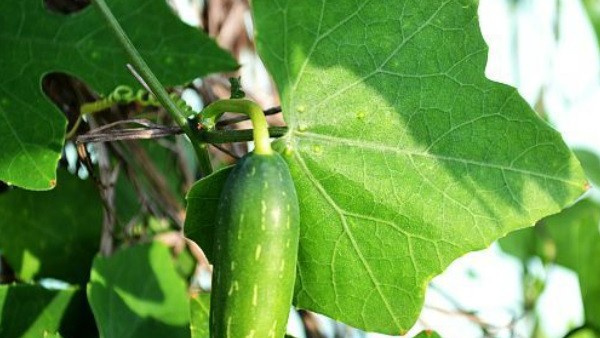
I. Monsoon Vegetables
1. Indian squash/round melon (tinda): Commonly known as Tinda, this vegetable is also called Indian squash, round melon, Indian round gourd or apple gourd or Indian baby pumpkin. Indian squash is nutritious and has high water content, and help improves the metabolic functions in the body, making it a must-have during the monsoon [2]. You can add tinda to curries.
2. Bitter gourd (karela): Bitter gourd help regulate the blood sugar levels in your body and activates the insulin, thereby preventing its conversion to fat, and is highly beneficial for people with diabetes [3]. You can add this veggie to curries or make bitter gourd juice with lemon.
3. Bottle gourd (lauki): High in water content and rich in vitamin C and calcium, bottle gourd helps in maintaining a healthy heart and brings down bad cholesterol levels. Bottle guard or calabash can be cooked, juiced and dried.
4. Pointed gourd (parwal): Pointed gourd, also known as patol, potala or palwal has many therapeutic uses. Its antipyretic activity helps reduce fever and cold, a commonly occurring illness during the monsoon. This veggie can be eaten as stir fry or curries.
5. Button mushroom: Button mushrooms are the most common mushrooms which are an excellent source of vitamin D. Mushrooms are low in calories and have high antibacterial and immune system enhancing properties. Button mushrooms can be eaten during the monsoon after proper washing and cooking [4].
6. Radish (mooli): Rich in antioxidants and minerals, radish may help lower high blood pressure and reduce your risks for heart disease. This root vegetable is also a good source of natural nitrates that improve blood flow. The anti-inflammatory properties of radish prevent inflammation of the respiratory organs due to cold and fever [5].
Rajasthan Man Sleeps 300 Days A Year Due To Rare Disorder: Know More Here
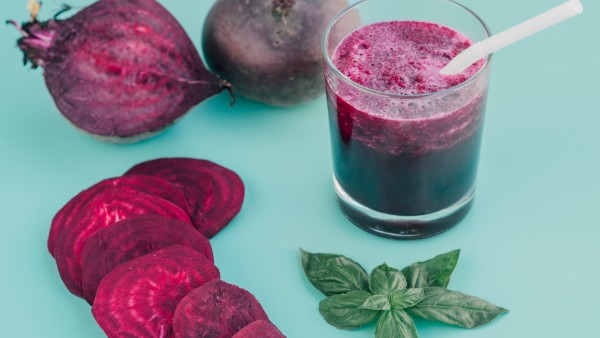
—
7. Beetroot (chukandar): High in fibre, beetroots help prevent constipation and piles. Consuming beets can help keep the waste materials moving through the intestines easily and without any strain. Beetroot is amazingly effective in maintaining the gut microbiome and its antimicrobial effects prevent the outgrowth of harmful bacteria.
8. Teasel gourd or spiny gourd (kakoda/kakrol/kantola): This spiky green vegetable is a monsoon vegetable that is not just healthy but also low in calories. Commonly known as spiny gourd or spine gourd, it is a great source of phytonutrients and is helpful in keeping seasonal cough, cold and other allergies at bay, due to its anti-allergen and analgesic properties [6].
9. Elephant foot yam (ool/jimikand/suran): Packed with nutrition, vitamins and minerals, yam is a healthy monsoon vegetable. Yams provide several antioxidants that may have anti-cancer properties, and the phenolic compounds and flavonoids may help improve the body’s immunity, preventing the onset of any infections prevalent during the monsoon.
10. Ridge gourd (turai/tori): A long vegetable with spongy white flesh containing numerous seeds inside, ridge gourd is rich in fibre and can be consumed to reduce internal inflammation and alleviate cough and reduce swelling of the lymph glands [7].
11. Ivy gourd (kundru/kundri/tindora/tendli): Ivy gourd is rich in an orange-red pigment called beta-carotene, which has potent antioxidant effects. It is also rich in fibre, B vitamins, and iron and may help relieve occasional constipation and normalise blood sugar levels.
12. Corn (makka): Probably the most easily available food during the monsoons, corn is extremely nutritious. Touted as the ultimate healthy monsoon food, corn is low in calories and high in fibre. Corn can be boiled, steamed or roasted, and it is an extremely versatile food. It is also very rich in lutein and two phytochemicals that help improve your vision and help with reducing the chances of diarrhoea, which is quite common during the monsoon [8].
More about monsoon veggies:11 Must-Have Healthy Vegetables During The Monsoon
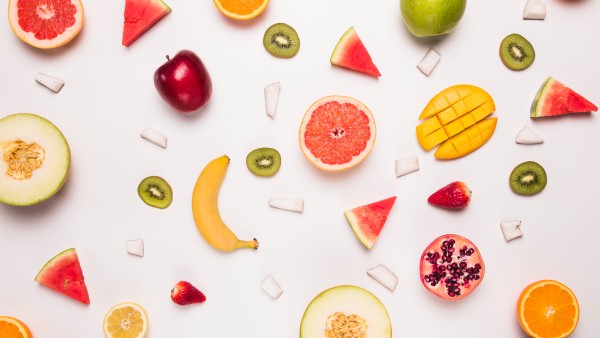
II. Monsoon Fruits
13. Jamun: Native to India, this colourful fruit is also black plum or Java plum. Jamun has several medicinal and health benefits and is one of the best home remedies for stomach pain and may help with diabetes and arthritis [9].
14. Litchi: On top of providing a significant amount of vitamin C, consuming litchi or lychee can help improve collagen synthesis and blood vessel health. Rich in potassium and healthy fats, lychee also contains omega-3 and omega-6 fatty acids. You should NEVER eat lychee on an EMPTY STOMACH or when skipping meals as it can lead to acute low blood glucose level and lead to encephalopathy (a condition that can alter brain functions, causing convulsions, coma and in some cases, death) [10].
15. Plum (ber): Plums are a rich source of fibre that makes them an ideal fruit for diabetics and heart patients. Apart from being low in calories, plums are also low in glycaemic index.
16. Cherry: A good source of vitamin C, cherries are also packed with potassium, fibre, and other nutrients that your body needs to function optimally. Consuming large amounts of cherry juice may lead to indigestion and diarrhoea.
17. Peach (aadoo): With 89 per cent water content, eating peaches can help get relief from dehydration and prevent its onset. The pulp and peel of fresh peach also prevent the development of cancer cells and neurodegenerative diseases. You can add peaches to salads or make smoothies [11].
18. Pomegranate (anaar): An excellent source of phytonutrients, pomegranates are said to have two to three times as much antioxidant activity as green tea or red wine. Studies have pointed out that pomegranates can help protect against cancer, lower blood pressure, improve cholesterol levels, and improve cognitive function [12].
Healthy Monsoon Fruits To Get Indulged In
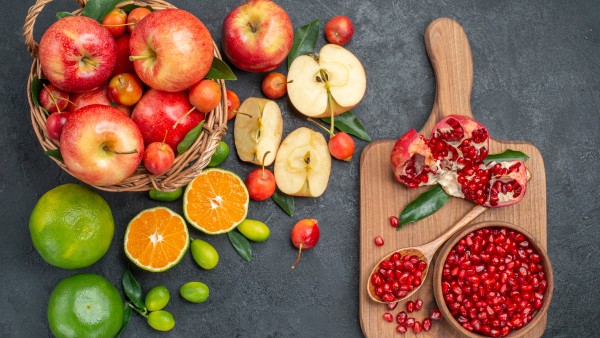
—
19. Apple: Apples are one of the most beneficial monsoon season fruits in India. Apples are high in fibre and low in energy density which makes them weight-loss-friendly fruit. Consuming apples daily (in a controlled quantity) can help improve your overall health
20. Banana: Packed with several nutrients such as magnesium, fibre and potassium, bananas are excellent for your overall health. Eating bananas can satiate hunger and boosts your energy level. In addition, gastrointestinal infections are one of the most common monsoon diseases, and regular consumption of bananas may help ease and prevent these issues [13].
21. Pear (naashapaatee): Several health experts say that pears are a must-have during the monsoon season. Pears are nutrient-dense, which means low in calories but high in nutrients, especially the immunity-boosting vitamin C.
22. Papaya: Eating one cup of papaya provides 87 mg of vitamin C, making the fruit a good source of the vitamin [14]. Raw papayas are also a great source of vitamin C, as well as vitamin A, folate, dietary fibre, calcium, potassium and omega-3 fatty acids, making them a great addition to your monsoon diet.
23. Gooseberry (amla/karonda): Indian gooseberry, also known as amla, is mostly eaten to ward away cough and cold and promote hair growth, but that’s not all [15]. Amla has been used to prevent common diseases in Ayurvedic medicine, and amla juice is known to balance the three doshas – vata, kapha and pitta. Amla should be a must-have in your monsoon diet as it can do wonders for your health during the rainy season as it helps improve the immune system and reduces inflammation.
Is Vitamin C Overdose Dangerous?
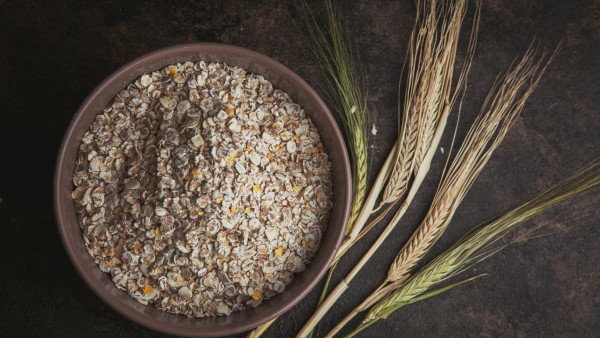
III. Monsoon Pulses/Cereals/Whole Grains/Legumes
24. Gram flour: Gram flour, also known as chickpea flour or besan, is something that is a staple in most Indian kitchens. Besan (chickpea flour) has fewer calories as compared to whole wheat flour and is the richest source of iron and vitamin B6 which strongly supports our immune system [16].
25. Brown rice: Health enthusiasts don’t just call brown rice the healthiest grain for no reason. Brown rice is rich in fibre, manganese and selenium. Selenium is an antioxidant that destroys cancer-causing cells and repairs our DNA. It regulates our thyroid glands and immune system. On the other hand, manganese contains a compound called superoxide dismutase, which prevents free radical damage.
Brown Rice Vs White Rice: Which Is The Healthier Option?
26. Oats: Oats are mostly consumed as breakfast and are rich in fibre. It is popularly known for its ability to curb bad cholesterol in the body. Studies have indicated that oats boost our immune system and help fight against bacteria, viruses, fungi and other parasites, thereby making it a great addition to your monsoon diet.
27. Barley: Barley is rich in plant lignans, which help the good bacteria to thrive in our intestines. It is also rich in vitamin C, which boosts our immune system. Eating barley porridge is a good way to maintain your health during the monsoon [17].
28. Chickpea: Chickpeas are the highest sources of zinc and copper, which are essential minerals to keep our immune system strong. Some studies point out that chickpeas can fight common cough and cold more than foods with high vitamin C content [18].
29. Almonds: Almonds have a good store of lean proteins, which is extremely good for the brain. Apart from supplying energy, almonds help in the repair of brain cells that are damaged during the life processes. Eating a handful of almonds will keep you healthy during the monsoon season.
10 Ways To Add Almonds To Your Diet
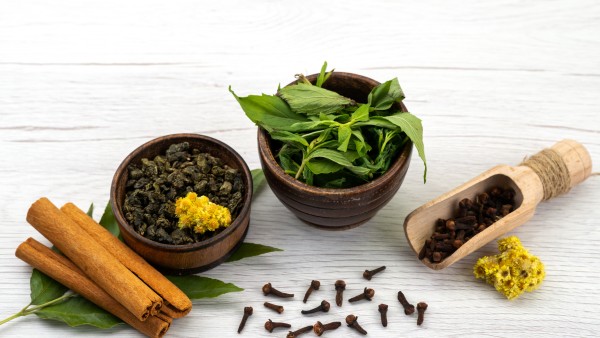
IV. Monsoon Spices/Herbs
30. Garlic: A compound called allicin present in garlic has many health benefits, making it the best home remedy to combat symptoms of a common cold. Adding garlic to your regular diet will help you fight cold and cough better, especially during the monsoon.
31. Ginger: Known for its anti-inflammatory properties, ginger helps improve circulation to the lungs and reduces inflammation. Ginger can be used for relieving nausea, vomiting (morning sickness), menstrual pain and minor infections [19]. The aroma and the taste of ginger make the perfect drink to refresh your body during the monsoon season.
32. Basil: A common ingredient in a variety of dishes, the herb can not only boost the taste of your dish but also boost your immunity. The queen of herbs is packed with medicinal values and nutrients. There are around 35 different types of basil species, and the most common amongst them is the holy basil or tulsi, which can be used to cure more than 300 different ailments [20].
20 Lesser Known Health Benefits Of Basil Leaves, Nutrition & Recipes
33. Coriander: Coriander or cilantro, also called Chinese parsley, is considered a magical herb in Indian markets. The nutrient value of coriander seed is different from the coriander leaf, which is packed with vitamin A, vitamin C, and vitamin K along with other traces of dietary sources and is considered a healing spice, making it a good addition to your monsoon diet. Using coriander in your diet can protect you against inflammatory conditions as well.
34. Mint: Mint leaves, commonly known as pudina, is one of the widely used aromatic plants. Pudina is not just used for culinary purposes but also for medicinal purposes. While generally it is recommended to skip greens during monsoon, mint leaves are an exception as it is a natural decongestant, helping battle colds and flu [21].
35. Parsley: Consisting of one of the highest concentrations of myricetin per 100 grams, parsley works brilliantly as an antioxidant to boost immunity.
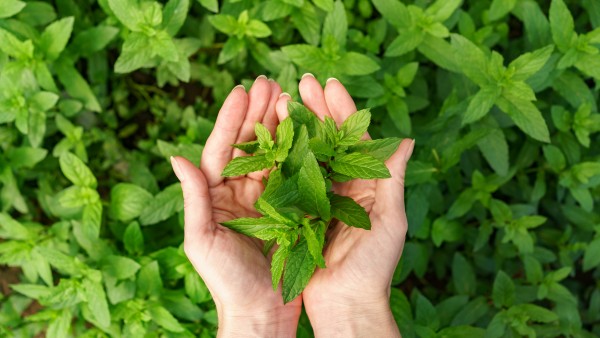
—
36. Neem: Another herb that can help boost your overall health and immunity during the monsoon season is neem. It is also great for balancing your pitta dosha and building immunity, and help fight infections.
37. Ashwagandha: Ashwagandha is also termed Indian ginseng and winter cherry; the herb is popular for managing stress. The therapeutic properties of ashwagandha are the major reason for its incorporation in modern medical science. Various studies have pointed out that ashwagandha possesses antibacterial properties that help protect your body against pathogenic bacteria. The leaf extracts and the root of ashwagandha are effective in eliminating Salmonella infection [22].
38. Mulethi: Mulethi, also known as liquorice, is proven to possess anti-diabetic properties, which helps in reversing and controlling the high sugar level in the blood. In addition to that, this herb is also a good source of antioxidants, thereby help in preventing the onset of various diseases, such as cold, sore throat and congestion [23].
READ RELATED: Coronavirus: What is dexamethasone and how does it work?
39. Guduchi: Guduchi is used in Ayurveda for the treatment of various infections, fevers, urinary tract disorders, digestive disorders as well as water-borne diseases like jaundice. It is often used as a home remedy for infections.
40. Giloy: Due to its medicinal properties, giloy has been used and advocated in Indian medicine for ages. Giloy helps remove toxins, purifies the blood and fights bacteria that cause diseases and can be mixed with amla and ginger powder to make calming tea for monsoon.
V. Other Monsoon Foods
41. Curd: Curd is rich in probiotics and can actually build better immunity by strengthening your gut and adding beneficial microorganisms to the healthy gut, making it a healthy and safe addition to your monsoon diet [24].
42. Egg: Packed with vitamins, minerals and proteins, boiled or scrambled (cooked) eggs are a good addition to your monsoon diet. Please avoid consuming raw eggs.
43. Honey: For ages, honey has been used both as a medicine and food. Honey is valued as one of the oldest and natural sweeteners long before sugar became widely popular. Honey is very high in beneficial plant compounds and offers several health benefits. Rich in antioxidants, honey helps build up the immune system, so don’t forget to add some honey to your monsoon diet [25].
Foods That You SHOULD NOT Eat Together, According To Ayurveda

VI. Monsoon Beverages
44. Kesar milk: Kesar, or saffron, is a spice that contains plant-derived chemicals and is found to be very helpful in preventing diseases. This makes it one of the best monsoon foods to be added to your monsoon diet.
45. Soup: One of the healthiest ways to ward off the monsoon coldness is a bowl of hot soup. Be it vegetarian or non-vegetarian, soup is comforting and beneficial in every way. Making a vegetable soup with a pinch of garlic, black pepper and butter will provide energy and help cure a mild cold and cough. Having warm soup will also aid in treating throat allergies. Add some pasta to the soup and make it a complete meal [26].
46. Herbal tea: Not all herbal teas are essentially ‘tea.’ Herbal teas are made from dried fruits, flowers, spices or herbs, and some of the best herbal teas are chamomile tea, peppermint tea, ginger tea, hibiscus tea etc. Health benefits from drinking herbal tea include relaxation, pain reduction, and improved body systems such as digestive and immunity, making herbal teas a good addition to your monsoon diet.
16 Ways To Make Your Daily Tea Super Healthy
47. Masala tea: Masala tea is extremely popular in India and mixture of several ingredients, including cardamom, ginger, cinnamon, black pepper, and cinnamon. It is known to help reduce inflammation, boost immunity and aids digestion, making it a good beverage option for monsoon. It is especially beneficial for the elderly [27].
48. Water: Chances are more that you will reduce your fluid intake during the monsoon. Ensure that you are keeping yourself hydrated. Also, try to drink boiled and filtered water to avoid infections.
You must avoid chilled drinks like lemonade as it can build phlegm and can also irritate the throat.

Best Monsoon Foods For Kids
One easy way to take care of your kids during the rainy season is to plan the right monsoon diet for them. With the COVID-19 pandemic still looming, building up immunity has become pivotal [28].
Foods That Boost Immunity In Kids
Monsoon foods are not very different from the regular healthy diet. But during monsoons, a little extra care is called for. Make sure you consume homemade food, as it eliminates any possibilities of food contamination. Wash fruits and vegetables well before consumption. To be double sure, soak all fruits and vegetables in a large bowl of water-vinegar mix. Here is a list of monsoon foods for kids.
Eggs: With one egg every day, your child is bound to get a good dose of all required vitamins, minerals and proteins, along with the power to fight colds and coughs. Its warmth giving quality is just ideal for the monsoon.
Almonds: Soak the almonds in water overnight and peel them before you give them to your child. You can also grind the almonds and mix them in milk. Good eyesight, glowing skin and a healthy immune system – this is what you ensure for your child when you give them those two gems every day.
Fresh fruits: Every fruit of a particular season has the ability to ward off diseases related to that season, such as jamun, litchi, pomegranate, plum, apples etc. Fruits like jamuns are packed with essential nutrients and vitamins, while plums keep cold and flu at bay. So, do not forget to include a large helping of seasonal fruits in your child’s monsoon diet. Also, try to get your children to have the fruit itself rather than juicing it [29].
You can also give them the following foods:
- Kesar milk
- Soup
- Ginger
- Garlic
- Pulses
- Spices
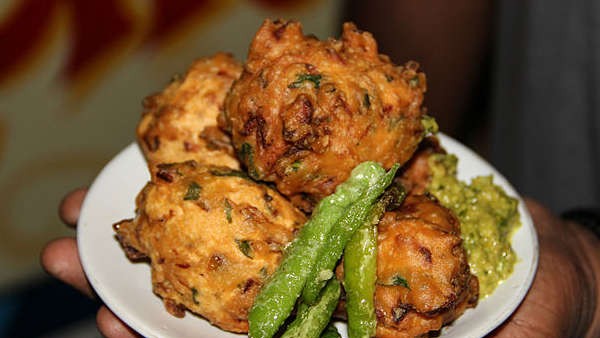
Foods To Avoid During Monsoon Season
1. Pakoras
Pakoras with tea is an irresistible snack during monsoons and maybe even the most common food eaten during monsoon in India. But it is also one of the main foods to avoid during rains as it is deep-fried. Foods that contain a lot of oil takes a lot of time to be digested in the system due to the increase in humidity. Therefore, avoid deep-fried foods to not end up with an upset stomach [30].
2. Chaat
This is the second favourite food to consume when the weather is cold and lovely. However, chaat sold on the roadside is highly infectious in the rainy season due to the contaminated water being used. The chutneys and spices used to make chaat are not a healthy option to consume during the rainy season.
3. Samosa/kachori
Samosas or kachori should not be eaten during the monsoon. The stuffing can cause an upset stomach, acidity, diabetes, and obesity when consumed on a regular basis.
4. Indo-Chinese treats
Roadside Chinese food should be avoided in the monsoon season due to the usage of contaminated water and the dirt carried by flies on the road. The other reason why you should avoid these foods is because of the high usage of artificial colours, Ajinomoto, and stale oil.
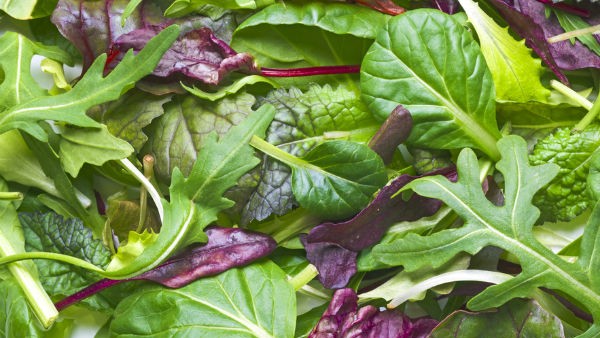
—
5. Leafy vegetables
Yes, you read that right. You might be surprised to find leafy vegetables on the list of foods to avoid in the monsoon. Doctors advise you to consume a lot of leafy veggies due to their high source of folate, B12 and Vitamin K. However; it is best to avoid them in the monsoon as the leaves are usually damp, dirty and they carry a lot of germs which can lead to stomach infections [31].
6. Seafood
Seafood should definitely be avoided during monsoon. Monsoon is the breeding season for fish, and it should be avoided at any cost. Fish is commonly stored for many days and may not be fresh. And fishes contain eggs inside their bodies, which can cause stomach infection or severe food poisoning when consumed.
7. Carbonated drinks
Aerated and carbonated drinks are always on the list of foods to avoid in any weather. These so-called refreshing drinks reduce mineral levels in our body also reduce enzyme activity leading to indigestion. On the other hand, it is one of the reasons for unhealthy weight gain due to the high sugar content [32].
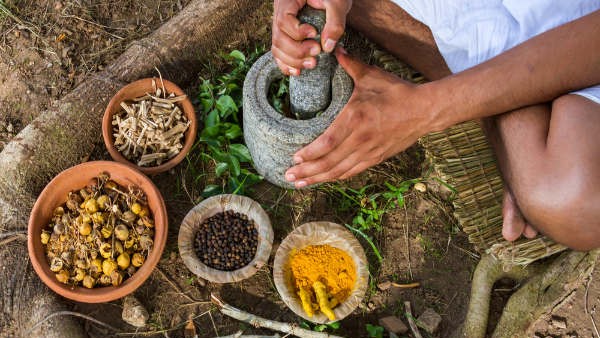
Ayurveda Tips For A Healthy Monsoon
The copious rain-bearing clouds of the monsoon season bring along with them innumerable diseases and infections. Our age-old medical science, Ayurveda, comes to our rescue in many ways to stay fit during the season of diseases and illnesses. Here are some Ayurveda tips for a healthy monsoon.
Tip 1: It is always better to watch what we eat, especially during this season. According to Ayurveda, you must avoid spicy foods during the monsoon.
Reason: The nature of spicy foods is such that it raises the body temperature and increases the blood flow, leading to a lot of skin allergies and diseases like pyoderma. So next time when your mind longs to eat hot spicy pakoras while it is raining, please give it a second thought.
Tip 2: Consuming bitter herbs is beneficial during monsoon.
Reason: Neem has the natural ability to ward off all kinds of germs, thus improving our immunity and keeping monsoon-related diseases at bay. The herb is packed with antioxidants and can help prevent bacterial and fungal infections [33].
Tip 3: Tulsi with warm water is also an excellent remedy prescribed by ayurvedic experts.
Reason: Also known as the king of herbs, tulsi acts as a rich source of many important minerals and antioxidants. The anti-inflammatory properties of tulsi help prevent the risk of many deadly fevers like dengue and malaria, which are more prevalent during the time of monsoon [34].
Tip 4: Fenugreek, popularly known as methi, is another ayurvedic herb that helps to act as a shield against all deadly monsoon diseases.
Reason: Fenugreek is an energy booster, and it contains all the necessary minerals for it to take care of our body, even during fever and digestive disorders.
Tip 5: Turmeric, when consumed with warm milk, according to Ayurveda, wards off a sore throat, chest congestion and the common cold, which are the common monsoon-related discomforts.
Reason: The curcumin, which is present in adequate amounts in turmeric, has powerful anti-inflammatory and antioxidant properties. It gives a boost to the immune system, thus helping us escape from the cold clutches of the monsoon weather [35].
Tip 6: Another thumb rule of Ayurveda, during rainy weather conditions, is consuming bitter foods like bitter gourd, which can help prevent the onset of infections.
Reason: Being an excellent source of vitamin C, which is a natural antioxidant, bitter gourd helps to chase away the harmful free radicals from our body, thus helping us to stay fit and healthy.
Tip 7: Though deep-fried foods may seem like a good idea while it is raining outside, they are in no way good for your health, especially during the monsoon.
Reason: The large amounts of oil present in the deep-fried snacks are hard to digest and pose a danger to the cardiovascular system. This, in turn, affects one’s ability to develop resistance to diseases.
Monsoon Allergies: Types Of Allergies Common During The Season And Ways To Manage Them

On A Final Note…
Amidst the COVID-19 pandemic, you must take of your health and immunity levels this monsoon so as to avoid the risk of catching any form of illnesses, especially the ones that could compromise your respiratory health. Stay indoors, drink hot fluids and keep your surroundings clean.
[image source: freepik]
Source:








